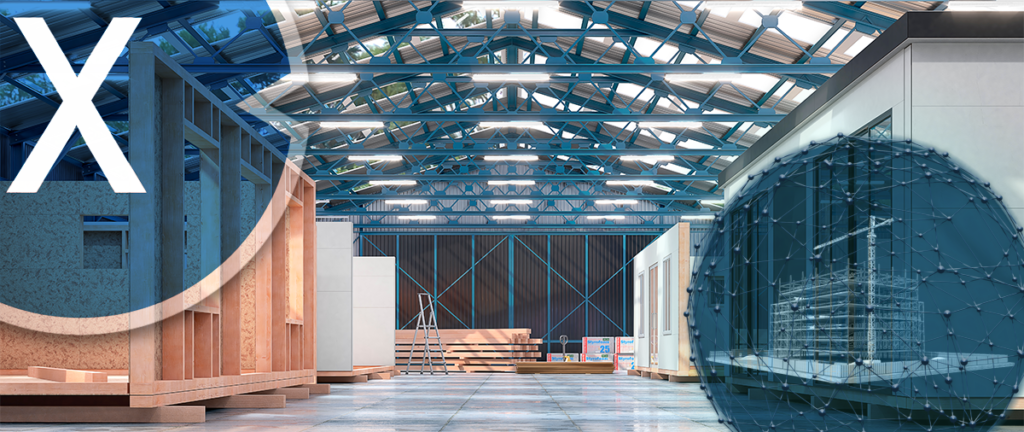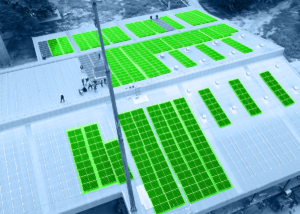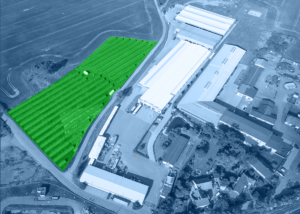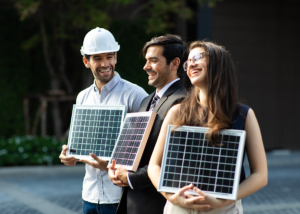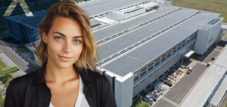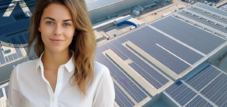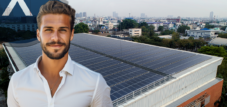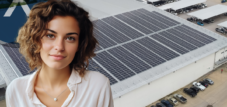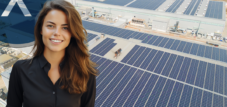Smart Renewable Energy Buildings & Logistics – Top Ten Sustainable Construction Technology in New Buildings and Renovations for Industry & Logistics Energy Infrastructure
Language selection 📢
Published on: July 14, 2023 / update from: July 14, 2023 - Author: Konrad Wolfenstein

Sustainable construction technology in new buildings such as renovation for industry & logistics energy infrastructure - Image: Xpert.Digital
Focus on energy efficiency: Smart solutions for energy-efficient renovations and new buildings
Innovation for climate protection: Smart Renewable Energy Buildings & Logistics (SREBL) as the key to the sustainable construction industry - intelligent buildings, green logistics, the synergy of SREBL for a sustainable energy future
Smart Renewable Energy Buildings & Logistics is a groundbreaking concept based on sustainable construction technology and energy infrastructure for energy-efficient renovation and energy-efficient new construction. It combines intelligent technologies, renewable energies and efficient logistics to optimize buildings and their energy supply and make a contribution to climate protection.
A central feature of SREBL is the integration of renewable energies in buildings. Photovoltaic modules on the roofs generate electricity from solar energy, which can either be used directly in the building or stored in battery storage. This decentralized energy generation reduces the need for electricity from conventional sources and thus reduces CO2 emissions. In addition, excess electricity can be fed into the public grid and used for other purposes.
Another important aspect of SREBL is the energy-efficient renovation of existing buildings. By using energy-efficient materials, improved insulation and modern heating and cooling systems, older buildings can be brought up to date and their energy consumption can be significantly reduced. This not only leads to a reduction in environmental impact, but also cost savings for building owners.
A key concept of SREBL is the integration of intelligent technologies. Sensors and IoT devices monitor energy consumption, room temperature and other parameters in real time. This data is analyzed and enables precise control of the building infrastructure to further optimize energy consumption. For example, heating and cooling systems can be automatically adjusted to user needs to increase comfort while minimizing energy consumption.
Logistics also plays an important role in SREBL. An efficient supply of building materials and components is crucial for energy-efficient new construction and renovation. By using intelligent logistics solutions, transport routes can be optimized and empty runs can be avoided. In addition, precise planning and coordination of construction activities enables a reduction in energy consumption during the construction phase.
SREBL not only offers ecological benefits, but also offers economic opportunities. The development and implementation of sustainable construction technologies and energy infrastructure creates new jobs and promotes the local economy. Additionally, buildings with an SREBL approach can significantly reduce their energy consumption, resulting in long-term cost savings.
The SREBL concept has already gained attention in many regions around the world. Governments, companies and organizations are increasingly relying on sustainable construction technologies and energy-efficient buildings to achieve their climate goals. Innovative projects and research initiatives continue to drive SREBL's development and offer the opportunity to find solutions to the challenges of climate change and the energy transition.
➡️ Smart Renewable Energy Buildings & Logistics offers a holistic and future-oriented approach to energy-efficient new construction and energy-efficient renovation. By combining renewable energies, intelligent technologies and efficient logistics, buildings can become active participants in the energy supply system and make a positive contribution to climate protection. SREBL is a way to realize the vision of a sustainable and emission-free future in the construction sector.
📣 Energy-related renovation and new construction, consulting, planning and implementation for industry, retail and municipalities
Our experienced team will support you in optimizing your buildings to reduce energy consumption and promote sustainable energy use with photovoltaics. We analyze your individual needs and create tailor-made concepts that make sense both economically and ecologically. Regardless of whether it is about the energy-efficient renovation of existing buildings or the construction of new energy-efficient structures, we are at your side. Industrial facilities, retail buildings and municipal facilities can reduce their energy costs and reduce environmental impact while improving the comfort and efficiency of their buildings through our tailored solutions.
👨🏻 👩🏻 👴🏻 👵🏻 Energy-saving renovation and new construction, advice, planning and implementation for private households
We offer comprehensive support for private households in the energy-efficient renovation and construction of new buildings with photovoltaics. Our experienced team is at your side to help you advise, plan and implement your sustainable energy solutions. We analyze your energy consumption, identify savings potential and develop tailor-made concepts to improve your energy efficiency. From improving building insulation to installing energy-efficient windows and doors to installing photovoltaic and solar systems - we accompany you step by step to make your home more energy efficient and environmentally friendly. Trust in our expertise and benefit from the numerous advantages that energy renovation and the use of renewable energies offer you. Together we will create a sustainable future for your home.
Plan your solar system for the most common applications conveniently online with our solar system planner!
With our user-friendly solar system planner you can plan your individual solar system online. Whether you need a solar system for your home, your business or for agricultural purposes, our planner offers you the opportunity to take your specific requirements into account and develop a tailor-made solution.
The planning process is simple and intuitive. You simply enter relevant information. Our planner takes this information into account and creates a tailor-made solar system that meets your needs. You can try out different options and configurations to find the optimal solar system for your application.
Additionally, you can save your plan to review later or share with others. Our customer service team is also available to answer your questions and provide support to ensure your solar system is optimally planned.
Use our solar system planner to plan your individual solar system for the most common applications and advance the transition to clean energy. Start now and take an important step towards sustainability and energy independence!

The solar system planner for the most common applications: Plan the solar system online here - Image: Xpert.Digital
More about it here:
Top 10 construction companies/construction companies and companies for new construction and renovation
Goldbeck GmbH
Goldbeck GmbH is one of the leading companies in hall construction, industrial construction and commercial construction in Germany. It is characterized by its modular design and its experience in implementing large projects.
Max Bögl Bauservice GmbH & Co. KG
Max Bögl Bauservice GmbH & Co. KG is a renowned construction company that specializes in industrial and commercial construction. With extensive experience and expertise, the company offers tailor-made solutions for its customers.
Köster GmbH
Köster GmbH is an established construction company that is active in hall construction, industrial construction and commercial construction. She has extensive knowledge and expertise in the construction of industrial plants, logistics centers and commercial properties.
Wolff & Müller Holding GmbH & Co. KG
Wolff & Müller Holding GmbH & Co. KG is an important construction company with many years of experience in commercial and industrial construction. The company is known for its expertise in the planning and implementation of halls and industrial facilities.
Zech Group GmbH
Zech Group GmbH is a diversified company that is also active in the field of industrial and commercial construction. With its comprehensive expertise, the Zech Group realizes demanding projects such as production facilities, logistics centers and commercial properties.
BAM Deutschland AG
BAM Deutschland AG is part of the BAM Group and has extensive experience in commercial and industrial construction. The company offers tailor-made solutions for customers from various industries and focuses on quality and innovation.
Hochtief AG
Hochtief AG is an international construction company that is also active in industrial and commercial construction. With its many years of experience and extensive know-how, Hochtief realizes demanding projects in this area.
Porr AG
Porr AG is a renowned construction company that is also active in industrial and commercial construction. With its focus on quality and innovation, Porr AG offers tailor-made solutions for customers from various industries.
Vollack Group
The Vollack Group is an expert in the field of industrial and commercial construction. The company develops and realizes individual projects, including production facilities, logistics centers and commercial properties.
Berger Bau GmbH
Berger Bau GmbH is a construction company that specializes in hall construction, industrial construction and commercial construction. The company is known for its high quality, timely implementation and tailor-made solutions.
Sustainability in focus: The synergy between large and small construction companies and experts in renewable energies, warehouse optimization and building planning
The collaboration of large and small construction companies with experts in the field of renewable energy, warehouse optimization and building planning offers a variety of advantages and strengths. Here are some important aspects:
1. Expertise in renewable energy
The renewable energy experts bring in-depth knowledge and many years of experience with regard to the integration of solar, wind or water-based energy sources in construction projects. They can support construction companies in planning and implementing sustainable energy solutions, be it through installing photovoltaic systems on roofs, using geothermal energy or implementing energy storage systems. By using renewable energy, construction companies can reduce their carbon footprint and achieve long-term cost savings.
2. Warehouse optimization
Working with warehouse optimization experts allows construction companies to improve their logistics processes and reduce costs. By analyzing storage capacities, material flows and process optimization, bottlenecks can be eliminated, inventories reduced and delivery times shortened. This contributes to more efficient use of resources and increased productivity.
3. Building planning and design
Building planning experts contribute their know-how in terms of efficient room design, optimized floor plan planning and ergonomic workplace design. You can support construction companies in developing sustainable and functional buildings that meet the needs of users. Through efficient space planning, construction companies can maximize floor space, improve energy efficiency and reduce operating costs.
4. Innovation potential
Collaborating with experts in these fields opens up new opportunities for construction companies to innovate. By using new technologies, materials and planning methods, construction companies can strengthen their competitiveness and develop innovative solutions that are in demand in the market. The experts bring their specialist knowledge and experience from various projects to develop tailor-made solutions for the specific requirements of construction companies.
5. Competitive advantages and sustainability
Working with experts in renewable energy, warehouse optimization and building planning can lead to significant competitive advantages. Construction companies that focus on sustainability and efficiency are able to attract customers seeking environmentally conscious construction and energy solutions. By optimizing logistical processes, construction companies can reduce costs and make competitive offers.
➡️ Working with experts in renewable energy, warehouse optimization and building design offers construction companies a range of benefits, including expertise, innovation potential, competitive advantage and sustainability. By drawing on this expertise, construction companies can make their projects more efficient, sustainable and competitive.
➡️ Smart Renewable Energy Buildings & Logistics
What is the difference between Smart Renewable Energy Buildings & Logistics and Smart Buildings?
Smart Renewable Energy Buildings & Logistics (SREBL) and Smart Buildings are both concepts based on intelligent technologies to make buildings more energy efficient and sustainable. However, there are some differences between the two approaches.
Smart buildings generally refer to buildings equipped with advanced technology to optimize energy consumption, increase comfort and improve operations. These technologies include, for example, building automation systems, sensors, connected devices and real-time data analysis. Smart buildings enable precise control and monitoring of various systems in the building, such as heating, ventilation, air conditioning, lighting and security.
In contrast, SREBL focuses specifically on the use of renewable energy and sustainable construction technologies in buildings. It's about not only making buildings intelligent, but also converting their energy supply to renewable energies and optimizing logistical processes for an energy-efficient new building or renovation. SREBL integrates solar panels, battery storage and other renewable energy sources into building infrastructure to reduce the need for conventional electricity and reduce CO2 emissions. SREBL also attaches great importance to the use of energy-efficient materials, improved insulation and state-of-the-art heating and cooling systems to minimize the buildings' energy consumption.
Another difference lies in the consideration of logistics. SREBL places a particular focus on optimizing transport routes and reducing energy consumption and emissions related to the supply of building materials and components during the construction process. Intelligent logistics plays an important role in the implementation of SREBL to avoid empty runs, make transport more efficient and enable precise planning and coordination of construction activities.
In summary, Smart Buildings is a broader term that refers to the use of intelligent technologies to optimize buildings, while SREBL represents a more specific approach based on renewable energy, sustainable construction technology and efficient logistics for energy renovation and energy efficient new construction . SREBL thus represents a further development of the concept of smart buildings by focusing on sustainability and renewable energy.
Smart Buildings - Intelligent buildings
An alternative wording for “smart buildings” is “intelligent buildings”. This designation emphasizes the integration of advanced technologies and automation systems in the construction process and the result, namely buildings that are quick, energy -efficient and user -friendly. “Intelligent buildings” illustrates the idea of buildings that go beyond conventional buildings and are equipped with a variety of networked devices, sensors and systems in order to optimize the operation, sustainability and the use of use.
Smart buildings, also known as intelligent buildings or connected buildings, are buildings that use advanced technologies and automation systems to improve comfort, efficiency and sustainability. By integrating information technology, sensing and communication technologies, smart buildings become intelligent and responsive environments.
The main goals of a smart building are to optimize energy consumption, improve user experience and reduce environmental impact. By connecting devices, sensors and systems within a building, data is collected, analyzed and used to optimize the building's operations and performance.
A smart building can include various technologies and systems, such as: E.g.:
1. Building automation systems
These systems control and monitor various aspects of the building, such as lighting, heating, ventilation, air conditioning (HVAC), security systems and access control. Automated controls and real-time data can improve energy efficiency and comfort.
2. Sensors and actuators
Sensors record data such as room temperature, air quality, presence of people and brightness. This data is used to control lighting, HVAC systems and other building functions. Actuators enable the remote control and automation of devices and systems.
3. Energy management and building control systems
These systems monitor and analyze energy consumption in the building and enable optimal control of energy flows. They help to identify savings potential and implement energy-efficient measures.
4. Connectivity and IoT
Smart buildings use the networking of devices and systems via the Internet of Things (IoT). This allows different components to communicate with each other and exchange information. This enables comprehensive monitoring, remote control and analysis of building operations.
5. Data analysis and artificial intelligence
By analyzing large amounts of data, patterns and trends can be identified to further optimize the operation of the building. Artificial intelligence (AI) algorithms can be used to make predictions, detect deviations and make automatic adjustments.
➡️ The advantages of smart buildings are diverse. They can provide energy savings, improve occupant comfort, reduce operating costs, increase safety and reduce environmental impact. In addition, smart buildings also offer flexibility and scalability to respond to changing requirements and new technologies.
➡️ Smart buildings play an important role in the development of smart cities by creating sustainable and efficient buildings and contributing to the overall optimization of urban infrastructure. They are a key element for a sustainable and networked society.
Building-integrated photovoltaics, Smart Renewable Energy Buildings & Logistics and Smart Buildings: The synergy for sustainable and intelligent buildings
Building integrated photovoltaics (GIPV) is an innovative concept that seamlessly integrates solar panels into the building envelope to generate renewable energy while creating aesthetically pleasing buildings. Partially transparent solar modules in particular offer the possibility of using sunlight while maintaining a certain level of transparency.
The use of GIPV offers a number of advantages. Firstly, the integration of solar modules into the building envelope allows for maximum use of the available space and optimizes energy production. The solar energy that falls on the modules can either be used directly in the building or stored in battery storage. This helps reduce the need for conventional electricity and reduces CO2 emissions.
Another advantage of GIPV is the aesthetic integration of the solar modules. Partially transparent solar modules allow daylight to enter the building and generate electricity at the same time. This creates pleasant and natural lighting in the interior. In addition, the adaptability of the solar modules to different architectural styles allows them to be harmoniously integrated into the building envelope without compromising the design or aesthetics.
Smart buildings go one step further and combine the integration of GIPV with intelligent technologies and automation systems. Smart buildings use sensors and IoT devices to monitor energy consumption, indoor climate and other parameters in real time. This data is analyzed and enables precise control and optimization of the building infrastructure. For example, heating and cooling systems can be automatically adjusted to user needs to increase comfort while minimizing energy consumption.
Smart Renewable Energy Buildings & Logistics (SREBL) combine the advantages of GIPV and smart buildings with a focus on renewable energy and efficient logistics. SREBL aims to integrate sustainable construction technologies and energy infrastructure into the construction process. By integrating renewable energies such as GIPV, buildings can become active participants in the energy supply system and make a positive contribution to climate protection.
In addition, SREBL attaches great importance to efficient logistics. By optimizing transport routes and reducing empty runs, construction companies can minimize energy consumption and environmental impact during the construction phase. Precise planning and coordination of construction activities makes it possible to use materials and resources efficiently and thus save costs.
➡️ The integration of GIPV, Smart Buildings and SREBL offers numerous advantages for construction companies, owners and users of buildings. In addition to environmentally friendly energy production, it enables energy efficiency to be increased, room comfort to be improved and energy costs to be reduced. At the same time, it contributes to achieving climate protection goals and promotes a sustainable and future-proof construction industry.
Efficient and sustainable buildings: 'Smart' heat pumps and air conditioning systems
Smart Renewable Energy Buildings & Logistics (SREBL) and Smart Buildings with heat pumps and air conditioning are innovative approaches that aim to make buildings more energy efficient and sustainable. By integrating renewable energy, smart technologies and efficient heating and cooling technologies, they offer a range of benefits and opportunities.
SREBL places particular emphasis on the use of renewable energy to provide buildings with clean energy. By integrating photovoltaic modules on the roofs of the buildings, they can capture solar energy and convert it into electricity. This electricity can then be used directly in the building or stored in battery storage. The use of renewable energy reduces the need for electricity from conventional sources and thus contributes to reducing greenhouse gas emissions.
A key element of smart buildings is the integration of heat pumps and air conditioning systems. Heat pumps use ambient heat, for example from the air or the ground, to generate thermal energy for heating buildings. By using heat pumps, energy consumption for heating can be significantly reduced as they work more efficiently than conventional heating systems. Air conditioning systems, in turn, enable buildings to be cooled efficiently and ensure a pleasant indoor climate, especially in hot summer months.
Integrating heat pumps and air conditioning systems into smart buildings offers a number of advantages. Firstly, they enable precise control of room temperature, resulting in increased comfort for users. With intelligent sensors and IoT technology, heat pumps and air conditioning systems can be automatically adjusted to the individual needs and preferences of users.
In addition, heat pumps and air conditioning systems contribute to energy efficiency as they offer high performance with comparatively low energy consumption. They use existing energy sources such as ambient heat or electricity from renewable sources to meet heating and cooling needs. This leads to a reduction in energy consumption and associated cost savings.
The integration of heat pumps and air conditioning systems into SREBL offers an even more powerful solution. By combining renewable energy generation through photovoltaics, the use of heat pumps for heating and air conditioning for cooling, Smart Renewable Energy Buildings can further optimize energy consumption and achieve high efficiency. Intelligent energy management makes it possible to monitor, analyze and control energy consumption to maximize the comfort and energy efficiency of buildings.
Another advantage of smart buildings with heat pumps and air conditioning systems is their contribution to environmental protection. By using renewable energies and energy-efficient technologies, the buildings' carbon footprint is reduced. This supports efforts to combat climate change and the transition to a sustainable and emission-free energy supply.
➡️ Smart Renewable Energy Buildings & Logistics and Smart Buildings offer an integrated and sustainable solution for energy-efficient buildings with heat pumps and air conditioning systems. The combination of renewable energy production, intelligent technology and efficient heating and cooling technology enables optimal use of resources and a reduction in energy consumption. This leads to cost savings, improved indoor comfort and a lower environmental footprint of the buildings.
Renewable Energy Buildings what does that mean?
The term “Renewable Energy Buildings” means buildings that actively use renewable energies to cover their energy requirements. These buildings are designed and equipped so that they can efficiently use renewable energy sources such as sun, wind, water or biomass. The goal is to reduce the use of fossil fuels and to promote switching to sustainable and environmentally friendly energy sources.
Renewable energy buildings typically use various technologies and systems to generate and use renewable energy. Here are some examples:
1. Solar energy
Buildings with solar systems on the roof or on the facades can convert solar energy into electrical energy or use it to heat water. Photovoltaic systems convert sunlight directly into electricity, while solar thermal systems generate heat.
2. Wind energy
In some cases, buildings can be equipped with small wind turbines to harness wind energy. These turbines can be installed on the roof or near the building to generate clean electricity.
3. Geothermal energy
When using geothermal energy, heat pumps are used to extract natural heat energy from the earth and use it to heat and cool the building. Geothermal systems use the constant heat of the earth to provide a sustainable heat source.
4. Biomass
Biomass heaters or biogas plants can be installed in buildings to generate heat and electricity from biological waste or organic materials. This can be obtained from wood pellets, wood chips, plant residues or biodegradable waste.
5. Hydropower
In some cases, buildings can be equipped with micro-hydroelectric systems to generate energy from flowing water such as rivers or streams. These systems use water flow to turn turbines and generate electricity.
➡️ Renewable Energy Buildings are characterized by their energy-efficient construction and the use of energy-efficient materials and technologies. They can also include energy-efficient heating, ventilation and air conditioning systems, good thermal insulation, LED lighting and intelligent building automation to further optimize energy consumption.
➡️ The use of renewable energy in buildings is an important step towards reducing greenhouse gas emissions and promoting a sustainable energy economy. Renewable energy buildings help reduce carbon footprints, promote the use of clean energy sources and can lead to long-term cost savings through lower energy costs.
Capacitors & Compressors | Heat pumps & air conditioning systems
Capacitors and compressors play an important role in both heat pumps and air conditioning systems
Heat pump
A heat pump is a system that takes heat energy from a lower temperature source and brings it to a higher temperature to heat a building. The refrigerant circuit is used, which includes a condenser and a compressor.
- Condenser: The condenser is a heat exchanger in the heat pump through which the heated refrigerant passes. In this part of the system, the refrigerant releases heat energy into the environment and cools down in the process. The heat given off is used to heat the building.
- Compressor: The compressor is the heart of the heat pump. It increases the pressure of the refrigerant, which increases its temperature. Compression brings the refrigerant into the condensed state and ready for heat exchange in the condenser.
air conditioner
An air conditioning system cools the air in a room or building to create a comfortable indoor climate. A refrigerant circuit is also used here, which includes a condenser and a compressor.
- Condenser: The condenser in an air conditioner is used to remove heat energy from the room. The refrigerant is passed through the condenser, where it releases the heat to the outside environment and condenses.
- – Compressor: The compressor increases the pressure of the refrigerant, which leads to an increase in temperature. Compression brings the refrigerant into the condensed state and is ready to release heat in the condenser.
➡️ With a heat pump, the refrigerant circuit is used for both heating and cooling. The condenser and compressor play a crucial role in converting thermal energy and transferring heat between the refrigerant and the environment. In an air conditioning system, on the other hand, heat energy is removed from the room to achieve a cooling effect.
- Warehouses, production halls and industrial halls with their own power source from a photovoltaic roof system - Image: NavinTar|Shutterstock.com
- Industrial plant with its own power source from an outdoor photovoltaic system - Image: Peteri|Shutterstock.com
- Plan solar systems with photovoltaic solutions for freight forwarding and contract logistics
- B2B solar systems and photovoltaic solutions & advice
- Plan photovoltaics for warehouses, commercial halls and industrial halls
- Industrial plant: Plan a photovoltaic open-air system or open-space system
- Plan solar systems with photovoltaic solutions for freight forwarding and contract logistics
- B2B solar systems and photovoltaic solutions & advice
Technical advice on energy-efficient renovation and energy-efficient new construction with Xpert.Plus (warehouse optimization) and Xpert.Solar
I would be happy to serve as your personal advisor.
You can contact me by filling out the contact form below or simply call me on +49 89 89 674 804 (Munich) .
I'm looking forward to our joint project.
Xpert.Digital – Konrad Wolfenstein
Xpert.Digital is a hub for industry with a focus on digitalization, mechanical engineering, logistics/intralogistics and photovoltaics.
With our 360° business development solution, we support well-known companies from new business to after sales.
Market intelligence, smarketing, marketing automation, content development, PR, mail campaigns, personalized social media and lead nurturing are part of our digital tools.
You can find out more at: www.xpert.digital – www.xpert.solar – www.xpert.plus



